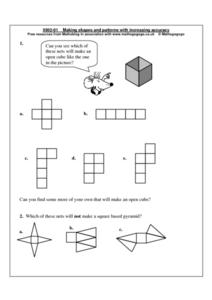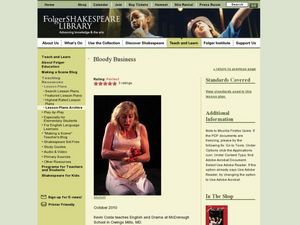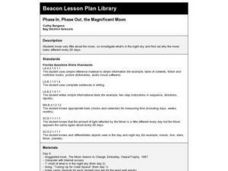Curated OER
Mexican Food
Students be able to: students identify the foods associated with Mexico and compare and contrast these foods with the foods associated wtih their region of the U.S. They write menus, take quizzes and practice ordering a meal in Spanish.
Curated OER
How and Why Has The White House Changed?
Learners discuss some of the changes the White House has undergone in more than two centuries. They compare three of the original drawings submitted for the design of the White House, available on the White House Historical Association...
Curated OER
Simple Sequencing
Fourth graders play a stand up version of musical chairs to find their sequencing partners. In this music and language arts lesson, 4th graders enjoy a game that requires them to organize a series of three pictures, then write sentences...
Alabama Learning Exchange
The Four Seasons
Students who are special needs and early elementary students study facts about the four seasons. They listen to read aloud books about each season before completing associated graphic organizers. They illustrate pocket books to hold all...
Curated OER
Gulping Guppies
Students recognize the phoneme /g/. Through listening and matching activities, students discriminate the phoneme /g/ from other letters and phonemes. They associate the phoneme /g/ with its letter representation and identify the phoneme...
Curated OER
Short 'e'
First graders recognize the short vowel e in written and spoken language. Through matching activities, they discriminate the short vowel /e/ from other phonemes. Students associate the phoneme with its letter representation and identify...
Curated OER
Match Those Sounds
In this matching of sounds learning exercise, students match up the sounds of "sh" and/or "ch" to eighteen pictures. Students fill in the blanks above each picture with a "sh" and/or "ch."
Curated OER
Making Shapes and Patterns With Increasing Accuracy
In this shapes and patterns worksheet, learners determine which of the 5 multiple choice nets can make an open cube like the blue one pictured on the worksheet. Students determine which of 3 nets will not make a square based pyramid.
Curated OER
What a Character !
Students identify traits associated with a character in a biography. In this character analysis lesson, students select a biography and discuss character traits. Students complete a related worksheets and complete a character description...
Curated OER
Customs
Students explore Chinese New Year. In this Chinese culture lesson, students read associated literature and use worksheets to explore aspects of the Chinese New Year. Students complete this lesson by making and hanging paper lanterns,...
Curated OER
Student Dictionary
Third graders examine the concept of alphabetizing. They develop a class dictionary, creating definitions of themselves, and typing in their names, pronunciation, and the definitions, and inserting their picture into their document.
Curated OER
8th Grade Math Properties
Eighth graders engage in a activity that is concerned with the properties associated with 8th grade Algebra. They solve problems using a variety of contexts and participate in using real world problems to create context. Students...
Curated OER
Building Vocabulary With Digital Photos
Student develop basic Spanish vocabulary using digital photography. In this Spanish vocabulary instructional activity, students use digital photographs to make flash cards and presentations throughout the year as they learn new words....
Curated OER
Beginning Sounds
In this recognizing beginning sounds worksheet, learners name the first pictures in the rows, look at the pair of pictures in the same rows, and circle the pictures with the same beginning sounds. Students circle six pictures with the...
Curated OER
What Are the Food Groups?
Students discover the four main food groups by categorizing their own diet. In this healthy eating activity, students utilize a chart with pictures of food to identify which food belongs in which food group. Students discuss why eating...
Curated OER
Bloody Business
Students research word frequencies in Macbeth and create a frozen picture inspired by a word. In this Macbeth lesson, students view Blood Will Have Blood and discuss the dual meaning of the word "blood." Students identify five major...
Curated OER
Stereo What?
Students define words associated with stereotypes. They identify the difference between stereotype, prejudice and discrimination and give examples of each. They discover their own personal biases.
Curated OER
Super Susie Slithered Slowly
Students complete a variety of activities related to the letter /s/ sound. As a class they recite an S tongue twister, then trace and write the letter S. Students then listen to the book "Slowly, Slowly, Said the Sloth" by Eric Carle,...
Curated OER
Lincoln's Birthday
Students in and ESL classroom discover and discuss the importance of Abraham Lincoln and why we celebrate his birthday. They study vocabulary associated with Abraham Lincoln.
Alabama Learning Exchange
Look at me!
Third graders write an autobiography and use pictures of themselves from past and present to illustrate it. They take pictures with a digital camera, scan pictures, and add them to a document.
Curated OER
Seasons
Students explore the four seasons. In this seasons lesson, students create a class tree. Students make leaves for the tree for each of the seasons. Students mark their paper into fourths and draw a picture of the seasons.
Curated OER
Seeing Cells
Students discuss what comes to mind when they hear the term cell and discuss what a cell is in biological terms. They look at pictures of cells and color a picture of a cell diagram, writing the job of each part as they go. After the...
Curated OER
Lesson 1: Hot, Not, or Silly
Students discover burn prevention and fire safety while sorting and classifying related pictures. In this early childhood lesson plan, students identify ways to prevent burns, and discuss various ways in which burns may occur. Students...
Curated OER
Phase In, Phase Out, the Magnificent Moon
First graders discuss why the moon appears to change shape. They use flashlights and balls to simulate the sun's light shining on the moon during its different phases. They read books, paint pictures and write sentences about the moon.

























